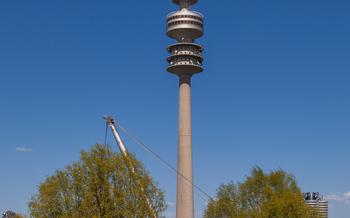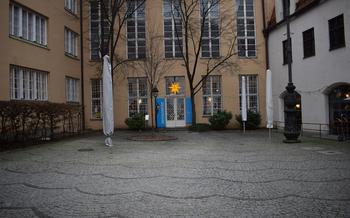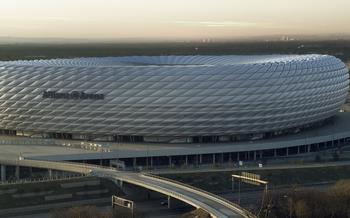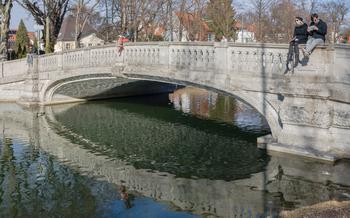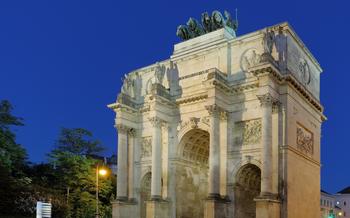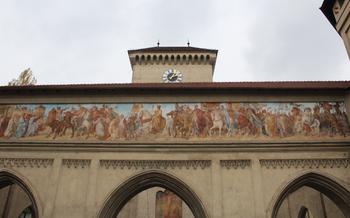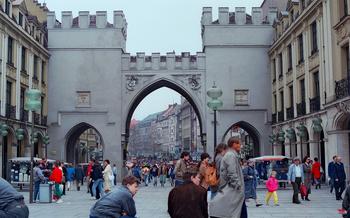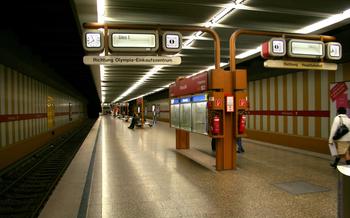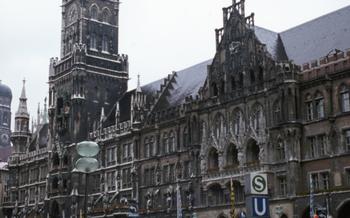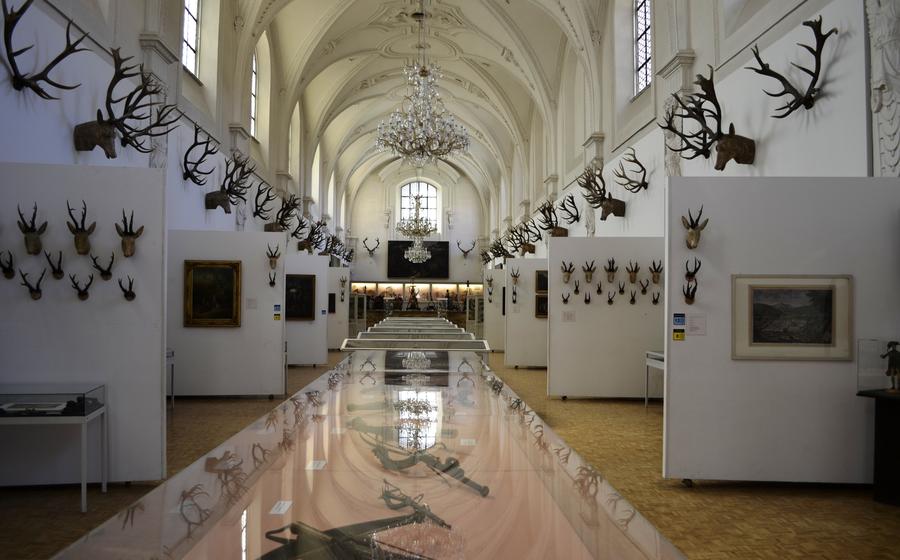
German Hunting and Fishing Museum
- Historical Background
- Museum's Collections
- Hunting Exhibits
- Fishing Exhibits
- Interactive Displays
- Educational Programs
- Architecture and Design
- Special Exhibitions
- Souvenirs and Merchandise
- Accessibility and Facilities
- Hours of Operation and Admission Fees
- Nearby Attractions
- Local Cuisine
- Insider Tip: Uncover the Hidden Treasures of the Museum
Historical Background
The German Hunting and Fishing Museum in Munich is a treasure trove of knowledge and artifacts that explores the rich history and cultural significance of hunting and fishing in Germany. Immerse yourself in the diverse exhibits that showcase hunting methods, fishing techniques, and the evolution of equipment. Discover the deep-rooted traditions and practices that have shaped these activities, and gain a profound appreciation for the role they have played in German history. The museum also highlights the importance of conservation efforts and the sustainable management of natural resources, ensuring the preservation of these traditions for future generations.
Museum's Collections
The German Hunting and Fishing Museum boasts a diverse collection of hunting and fishing artifacts that provide a glimpse into the rich history and cultural significance of these activities in Germany. From ancient hunting tools to elaborate taxidermied animals, the museum's exhibits offer a comprehensive overview of the development of hunting and fishing practices over the centuries.
Visitors can marvel at the intricate craftsmanship of medieval hunting weapons, such as crossbows and swords, and learn about the evolution of firearms from early muzzleloaders to modern rifles. The museum also houses a fascinating collection of taxidermied animals, including majestic deer, soaring eagles, and cunning foxes, which provide a glimpse into the diverse wildlife that inhabits Germany's forests and waterways.
Interactive displays and educational programs enhance the museum experience, allowing visitors to engage with the exhibits and gain a deeper understanding of the ecological relationships between humans and wildlife. Through hands-on activities and informative presentations, the museum promotes conservation efforts and raises awareness about the importance of protecting our natural heritage.
Hunting Exhibits
The German Hunting and Fishing Museum's exhibits delve into the rich history and traditions of hunting in Germany. Visitors can trace the evolution of hunting weapons and equipment, from primitive spears and bows to modern firearms and optics. Interactive displays showcase various hunting methods, from stalking and tracking to driven hunts and falconry. The museum also explores the cultural significance of hunting in Germany, where it has long been a way of life for many rural communities. Hunting trophies, such as antlers and mounted animals, are displayed alongside personal stories and anecdotes from hunters, providing a glimpse into the experiences and challenges they face.
Hunting has played a crucial role in German history and culture. It was once a necessity for survival, providing food and clothing for communities. Over time, it evolved into a sport and a pastime, enjoyed by people from all walks of life. The museum's exhibits highlight this transformation, showcasing the changing attitudes towards hunting and its impact on German society. Visitors can learn about the role of hunting in conservation efforts, as well as the debates and controversies surrounding this practice.
Fishing Exhibits
The German Hunting and Fishing Museum's fishing exhibits showcase the rich history and cultural significance of fishing in Germany. From traditional fishing gear to modern equipment, the museum offers a comprehensive overview of the diverse techniques and methods used by anglers throughout the centuries. Visitors can marvel at intricate fly rods, sturdy nets, and ingenious traps, each representing a unique approach to catching fish.
The exhibits also highlight the importance of fishing in German cuisine and economy. Germany's long coastline and numerous rivers and lakes have made fishing a vital source of food and sustenance for centuries. The museum showcases the different types of fish found in German waters, as well as the traditional recipes and culinary techniques used to prepare them. Visitors can learn about the role of fish in German festivals and celebrations, and how fishing has shaped the country's culinary identity.
Moreover, the museum emphasizes the importance of conservation efforts related to fishing and the protection of aquatic ecosystems. Interactive displays educate visitors about the impact of overfishing, pollution, and habitat destruction on fish populations. The museum also showcases the work of conservation organizations and individuals who are dedicated to protecting and restoring Germany's aquatic ecosystems.
Interactive Displays
The German Hunting and Fishing Museum's interactive displays are a highlight for visitors of all ages. These engaging exhibits allow visitors to experience the museum's collection in a hands-on and educational way.
One popular interactive display is a virtual hunting simulator, where visitors can test their shooting skills in a simulated hunting environment. Another exhibit allows visitors to explore the life cycle of a fish, from egg to adult, through a series of interactive touchscreens.
These interactive displays not only enhance the visitor experience but also play a crucial role in educating visitors about the ecological relationships between humans and wildlife.
I particularly enjoyed the interactive display on the history of fishing in Germany. It allowed me to learn about the different types of fishing gear used throughout the centuries and how fishing techniques have evolved over time.
For families with children, the interactive displays at the German Hunting and Fishing Museum are a great way to keep kids engaged and entertained while they learn about the museum's collection.
Must-See Interactive Exhibits:
Here are some specific interactive displays that I highly recommend:
The virtual hunting simulator: This is a great way to experience the thrill of hunting without having to actually shoot an animal.
The life cycle of a fish exhibit: This exhibit is both educational and visually appealing, and it's a great way to learn about the life cycle of a fish.
The history of fishing in Germany exhibit: This exhibit is a great way to learn about the different types of fishing gear used throughout the centuries and how fishing techniques have evolved over time.
The interactive map of the museum's collection: This map allows visitors to explore the museum's collection by geographic region and species.
Educational Programs
The German Hunting and Fishing Museum's dedication to promoting environmental awareness and conservation extends beyond its exhibits. The museum offers a range of educational programs and workshops that cater to visitors of all ages and interests. These programs are designed to provide a deeper understanding of the ecological relationships between humans and wildlife, as well as the importance of conservation efforts.
One of the most popular programs is the "Junior Rangers" program, which encourages children to explore the museum's exhibits while learning about wildlife conservation and responsible hunting and fishing practices. The program includes interactive activities, games, and hands-on experiences that make learning fun and engaging for young minds.
For adults and families, the museum offers guided tours, lectures, and workshops on a variety of topics related to hunting, fishing, and conservation. These programs are led by experienced experts who share their knowledge and insights on topics such as wildlife management, sustainable fishing practices, and the history of hunting and fishing in Germany.
Participation in these educational programs not only enhances visitors' understanding of the museum's exhibits but also contributes to the museum's mission of promoting conservation and environmental stewardship. The programs inspire visitors to become active advocates for wildlife conservation and to make informed choices that support sustainable practices.
Architecture and Design
The German Hunting and Fishing Museum is housed in a striking, modern building designed by the renowned architect Professor Justus Dahinden. Completed in 1972, the museum's unique architectural style is characterized by its bold, geometric forms and innovative use of materials. The building's exterior is clad in copper panels that have aged beautifully over time, giving the museum a distinctive patina.
The interior of the museum is equally impressive, with soaring ceilings, open spaces, and an abundance of natural light. The main exhibition hall is a vast, column-free space that allows visitors to fully appreciate the scale and grandeur of the exhibits. The use of glass and steel throughout the building creates a sense of transparency, connecting the museum's interior with the surrounding landscape.
One of the most striking features of the museum is its rooftop terrace, which offers panoramic views of the city and the nearby Alps. Visitors can relax on the terrace and enjoy the fresh air while taking in the stunning scenery. The museum's design is not only aesthetically pleasing but also highly functional. The careful placement of windows and skylights ensures that the exhibits are well-lit, while the open floor plan allows for easy circulation and flow of visitors.
Overall, the architecture and design of the German Hunting and Fishing Museum contribute significantly to its overall appeal and visitor experience. The building's unique style and innovative features make it a landmark in its own right and a must-see for anyone interested in architecture and design.
Special Exhibitions
In addition to its permanent collection, the German Hunting and Fishing Museum often hosts temporary or special exhibitions that delve deeper into specific aspects of hunting, fishing, and wildlife conservation. These exhibitions showcase unique artifacts, historical documents, and contemporary artwork related to these themes.
One notable special exhibition that I had the opportunity to visit focused on the history of falconry in Germany. The exhibition featured a stunning display of antique falconry equipment, including intricately carved perches, leather hoods, and bells. Visitors could learn about the techniques and traditions of falconry, as well as its cultural significance in German history.
Another special exhibition that left a lasting impression was dedicated to the underwater world of German lakes and rivers. The exhibition showcased a variety of taxidermied fish species, as well as interactive displays that allowed visitors to explore the aquatic ecosystems of Germany. It was fascinating to learn about the diverse range of fish species that inhabit German waters and the importance of protecting these fragile habitats.
These special exhibitions add a dynamic and engaging element to the museum experience. They offer visitors the opportunity to explore new perspectives on hunting, fishing, and conservation, and gain a deeper understanding of the cultural and ecological significance of these activities in Germany.
Souvenirs and Merchandise
The German Hunting and Fishing Museum boasts a well-stocked gift shop where visitors can purchase a variety of souvenirs and merchandise to remember their visit. From traditional hunting and fishing gear to unique artwork and taxidermied animals, there is something for everyone. The proceeds from the gift shop directly support the museum's conservation and educational initiatives, so every purchase helps to ensure the preservation of Germany's rich hunting and fishing heritage.
For those looking for a truly unique souvenir, the museum offers a range of limited-edition prints, sculptures, and other works of art inspired by the museum's collection. These pieces are created by local artists and craftsmen and are sure to become cherished keepsakes.
In addition to souvenirs, the gift shop also stocks a wide selection of books and DVDs on hunting, fishing, and wildlife conservation. These publications are an excellent resource for anyone who wants to learn more about these topics.
Whether you are looking for a gift for yourself or a loved one, the German Hunting and Fishing Museum gift shop is sure to have something to suit your needs. So be sure to stop by and pick up a souvenir to remember your visit.
Accessibility and Facilities
The German Hunting and Fishing Museum is committed to ensuring accessibility and providing a comfortable experience for all visitors. The museum is wheelchair accessible, with ramps and elevators available throughout the building. Visitors with disabilities can also borrow wheelchairs from the museum's reception desk.
The museum offers a range of facilities to enhance the visitor experience. Restrooms, including accessible restrooms, are conveniently located on each floor. A café is available for visitors to enjoy a light meal or snack, and a cloakroom is provided for storing coats and bags.
For those arriving by car, there is a paid parking garage located nearby. The museum also offers a limited number of disabled parking spaces, which can be reserved in advance.
My personal experience at the museum was very positive in terms of accessibility. I found the ramps and elevators to be well-maintained and easy to use. The staff was also very helpful and accommodating, providing me with directions and assistance as needed.
Hours of Operation and Admission Fees
The German Hunting and Fishing Museum is open to the public from Tuesday to Sunday, with varying hours depending on the season. During the summer months (April to October), the museum is open from 9:00 AM to 6:00 PM. In the winter months (November to March), the hours are slightly shorter, from 9:00 AM to 5:00 PM.
Admission fees are reasonable, with adults paying €7, children and students paying €5, and seniors paying €Families can take advantage of a discounted rate of €15 for two adults and two children. The museum also offers free admission to visitors with disabilities and their companions.
For those looking to save even more, the museum offers a combined ticket that includes admission to both the German Hunting and Fishing Museum and the nearby Deutsches Museum. This ticket costs €12 for adults and €8 for children and students.
It's worth noting that the museum is closed on Mondays, as well as on certain holidays such as Christmas and New Year's Day. To avoid disappointment, it's advisable to check the museum's website or call ahead before planning your visit.
Nearby Attractions
Located in the heart of Munich, the German Hunting and Fishing Museum is surrounded by a wealth of cultural and historical attractions. A short walk from the museum, visitors can explore the Deutsches Museum, a vast science and technology museum that offers interactive exhibits and hands-on experiences for all ages. Art enthusiasts can delve into the Alte Pinakothek, which houses a renowned collection of Old Master paintings, or the Neue Pinakothek, showcasing 19th-century art.
For those seeking a taste of Bavarian history and culture, the nearby Hofbräuhaus, a centuries-old beer hall, offers traditional Bavarian cuisine and lively entertainment. The Marienplatz, the city's central square, is just a stone's throw away, where visitors can admire the iconic Glockenspiel, a mechanical clock with moving figures that reenact historical scenes.
Nature lovers can escape the hustle and bustle of the city at the Englischer Garten, a sprawling English-style park with serene lakes, lush greenery, and picturesque walking trails. The park also features the Chinesischer Turm, a beer garden with a pagoda-style tower offering panoramic views of the city.
By combining a visit to the German Hunting and Fishing Museum with these nearby attractions, visitors can create a memorable and diverse itinerary that caters to a wide range of interests and preferences.
Local Cuisine
When in Munich, don't miss the chance to indulge in the city's culinary delights. Bavarian cuisine is renowned for its hearty and flavorful dishes, many of which feature game meat or fish. For a true taste of the region, try the traditional Weißwurst, a delicate white sausage served with sweet mustard and pretzels. Another must-try is Schweinshaxe, a crispy pork knuckle served with sauerkraut and dumplings.
To sample local fish dishes, head to Viktualienmarkt, a bustling food market just a short walk from the museum. Here, you'll find fresh catches of the day, as well as a variety of smoked and pickled fish. Be sure to try the Steckerlfisch, a grilled fish on a stick, a popular street food in Munich.
For a unique culinary experience, visit one of the many Biergartens in the city. These outdoor beer gardens often serve traditional Bavarian dishes, accompanied by freshly brewed beer. Enjoy a Maß, or liter, of beer while savoring the lively atmosphere and camaraderie.
And if you're looking for a sweet treat, don't miss the Dampfnudeln, a fluffy steamed dumpling served with a sweet fruit sauce. This traditional dessert is a beloved favorite in Bavaria and is sure to satisfy your sweet tooth.
Insider Tip: Uncover the Hidden Treasures of the Museum
Beyond the main exhibits, the German Hunting and Fishing Museum holds hidden gems waiting to be discovered. One such treasure is the museum's extensive library, housing a vast collection of books, manuscripts, and documents related to hunting and fishing. Here, visitors can delve deeper into the history, techniques, and cultural significance of these activities.
Another hidden gem is the museum's rooftop terrace, offering panoramic views of Munich and the surrounding Bavarian countryside. Visitors can take a break from exploring the exhibits and enjoy the fresh air while admiring the stunning cityscape. The terrace is also a popular spot for special events and photography enthusiasts.
For those interested in hands-on experiences, the museum offers workshops and guided tours that provide an immersive and interactive learning environment. These programs allow visitors to engage with experts, learn traditional hunting and fishing techniques, and gain a deeper understanding of wildlife conservation.
Remember, the best way to discover the hidden treasures of the German Hunting and Fishing Museum is to explore beyond the main exhibits and ask questions. The friendly and knowledgeable staff is always ready to share their insights and help visitors make the most of their visit.
